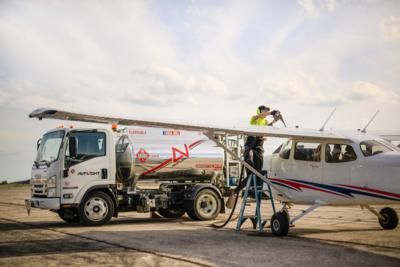Turns Out Getting Rid of Lead is Easier Said Than Done
By Gene Yarbrough
Unleaded aviation fuels have emerged as a critical topic of discussion within the aviation industry, driven by the need for more environmentally friendly and health-conscious alternatives to traditional leaded aviation fuels. The transition to unleaded aviation fuels represents a significant shift in the aviation sector, with implications for aircraft performance, environmental impact, regulatory compliance, and industry sustainability.

One of the primary motivations behind the development of unleaded aviation fuels is the desire to reduce the environmental footprint of aviation operations. Leaded aviation fuels, which contain tetraethyl lead, have been linked to air pollution and adverse health effects, prompting calls for cleaner alternatives. Unleaded aviation fuels offer the potential to lower emissions of harmful pollutants, such as lead and particulate matter, thereby improving air quality and reducing the environmental impact of aviation activities.
In addition to environmental considerations, the transition to unleaded aviation fuels also addresses health concerns associated with lead exposure. Pilots, ground crew, and communities living near airports are at risk of lead exposure from leaded aviation fuels, which can have detrimental effects on human health. By phasing out leaded aviation fuels in favor of unleaded alternatives, the aviation industry can help protect the health and well-being of individuals involved in aviation operations and those living in proximity to airports.
The development and certification of unleaded aviation fuels presents both challenges and opportunities for the aviation industry. Research and testing are essential to ensure that unleaded fuels meet the stringent safety and performance standards required for aviation applications. Collaboration between fuel manufacturers, regulatory agencies, aircraft manufacturers, and industry stakeholders is crucial to navigate the complex process of transitioning to unleaded aviation fuels effectively.
For nearly two decades, the aviation industry has expended significant efforts in developing and promoting unleaded avgas as a cleaner alternative to leaded aviation fuels. Extensive research, testing, and collaboration among industry stakeholders have been key in advancing the transition towards unleaded avgas. Efforts have focused on improving fuel formulations, addressing technical challenges, and ensuring compatibility with a wide range of aircraft engines. Regulatory bodies, fuel producers, aircraft manufacturers, and aviation organizations have worked together to support the development and adoption of unleaded avgas solutions. This collective effort highlights the industry's commitment to sustainability and environmental responsibility in aviation fuel technology. Two major players have emerged in the alternate fuel arena, GAMI with its G100UL offering and Swift with its UL94 option, both being commercially available albeit in limited markets.

Furthermore, the transition to unleaded aviation fuels requires investment in infrastructure and technology to support the production, distribution, and use of these new fuels. Fueling facilities, aircraft engines, and fuel systems may need to be modified or upgraded to accommodate the use of unleaded fuels effectively. Industry-wide coordination and cooperation are essential to facilitate a smooth and efficient transition to unleaded aviation fuels.
Despite the challenges associated with the transition to unleaded aviation fuels, there are significant benefits to be gained from adopting cleaner and safer fuel alternatives. Unleaded aviation fuels have the potential to enhance aircraft performance, reduce maintenance costs, and improve overall operational efficiency. By embracing unleaded fuels, the aviation industry can demonstrate its commitment to sustainability, innovation, and responsible stewardship of the environment.
The development and adoption of unleaded aviation fuels represents a critical step towards a more sustainable and environmentally conscious aviation industry. By phasing out leaded aviation fuels in favor of cleaner alternatives, the aviation sector can reduce its environmental impact, protect human health, and promote a more sustainable future for aviation. Continued research, collaboration, and investment are essential to support the transition to unleaded aviation fuels and ensure a smooth and successful implementation across the industry.
The FAA's EAGLE initiative has been at the forefront of spearheading the development and implementation of unleaded avgas in the aviation industry. Through the EAGLE program (Elimination of Aviation Gasoline Lead Emissions), the FAA has collaborated with industry partners to research, test, and certify unleaded aviation fuels as a viable alternative to leaded avgas. This initiative aims to address environmental concerns, reduce lead emissions, and ensure the availability of safe and reliable unleaded fuel options for piston-engine aircraft. The FAA's EAGLE initiative demonstrates the agency's commitment to promoting sustainable aviation practices and supporting the transition to cleaner fuels for the benefit of both industry and the environment.
 TikToker Arrested After Landing His C182 in Antarctica
TikToker Arrested After Landing His C182 in Antarctica Classic Aero-TV: Versatile AND Practical - The All-Seeing Aeroprakt A-22 LSA
Classic Aero-TV: Versatile AND Practical - The All-Seeing Aeroprakt A-22 LSA ANN's Daily Aero-Term (06.27.25): Hazardous Weather Information
ANN's Daily Aero-Term (06.27.25): Hazardous Weather Information ANN's Daily Aero-Linx (06.27.25)
ANN's Daily Aero-Linx (06.27.25) Aero-News: Quote of the Day (06.27.25)
Aero-News: Quote of the Day (06.27.25)




